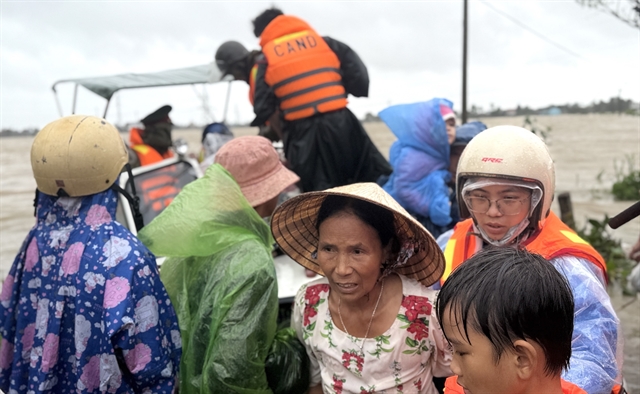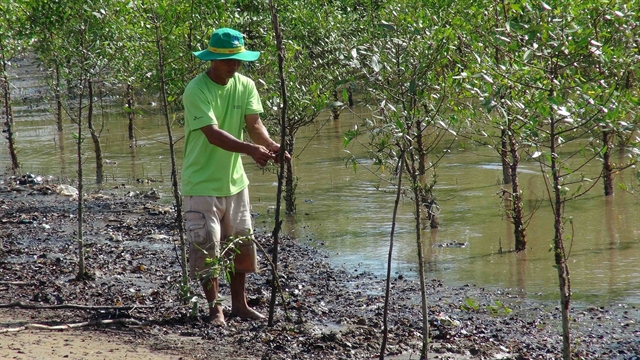 Society
Society

The Cửu Long (Mekong) Delta province of Trà Vinh is encouraging farmers to breed shrimp in mangrove forests as the practice offers sustainable incomes and helps to maintain the province's forest cover.

|
| Mangrove forests in Trà Vinh Province’s Cầu Ngang District. The province is encouraging farmers to breed shrimp in mangrove forests. The environmentally friendly practice offers sustainable profits and helps to maintain forest cover. – VNA/VNS Photo Thanh Hòa |
TRÀ VINH – The Cửu Long (Mekong) Delta province of Trà Vinh is encouraging farmers to breed shrimp in mangrove forests as the practice offers sustainable incomes and helps to maintain the province's forest cover.
With a coastline of 65 kilometres, the province has advantages for aquaculture development, but climate change and changes in the aquaculture environment have caused risks of disease.
To adapt to climate change, the province has shifted to other methods, including the shrimp – forest farming model, which is mostly implemented in the coastal districts of Cầu Ngang, Châu Thành and Trà Cú, and Duyên Hải Town.
Under the model, shrimp bred under extensive farming methods eat mostly natural food in the mangrove forest. The shrimp is 'clean' and is popular with consumers.
The variety that is mostly bred is black tiger shrimp, one of the country’s key shrimp exports.
Farmer Phạm Thái Bình in Duyên Hải District’s Long Vĩnh Commune has bred shrimp in a 3ha mangrove forest for nearly 20 years and earns an average profit of about VNĐ100 million (US$4,300) a year.
The profit is not as high as that from breeding shrimp under industrial farming, but it is stable.
“The shrimp – forest farming model is a sustainable livelihood as it reduces the risk of shrimp disease,” he said.
Bình breeds about 200,000 shrimp a year and staggers the release of shrimp fry into ponds in the forests four times a year in the dry season to avoid an oversupply in the main harvest season. As a result, the shrimp sells at high prices.
In the rainy season when the salinity of water fluctuates and shrimp are easily affected by disease, Bình breeds crabs in the mangrove forest.
Duyên Hải District authorities have encouraged farmers with modest finances who breed shrimp under intensive or super - intensive farming models to switch to shrimp – forest farming.
Duyên Hải has more than 8,500ha of shrimp, according to the district’s Bureau of Agriculture and Rural Development.
The shrimp – forest farming model accounts for nearly 60 per cent of the district’s shrimp farming areas.
Trần Kiến Chúc, chairman of the Đông Hải Commune People’s Committee in Duyên Hải, said that most farmers who breed shrimp in mangrove forests have stable incomes.
The shrimp - forest farming model offers a profit of VNĐ100 – 200 million ($4,300 – 8,600) per hectare a year.
Support
The province’s Agriculture Extension Centre last year supported 22 shrimp breeding households in Duyên Hải’s Đông Vĩnh and Long Vĩnh communes on a total breeding area of 36ha.
The households were provided VNĐ12 million ($520) per hectare for production costs, including 50 per cent of the cost to buy black tiger shrimp fry, 50 per cent of the cost to buy water - quality measuring tools, and a part of the cost to buy food and other material inputs.
They were also trained in advanced farming techniques, which help reduce production costs.
The supported households had an average yield of 700 kilogrammes of black tiger shrimp after breeding for three months and an average profit of VNĐ74 million ($3,200) per hectare.
Huỳnh Hoàng Ân, in Long Vĩnh Commune, said he received support to breed shrimp in a 2.5ha cajuput forest.
The costs to feed the shrimp are not high because they eat mostly natural food. “Shrimp bred under the model grow well and have few diseases,” he said.
Ân has expanded his shrimp – forest farming area to 7ha.
Nguyễn Văn Phùng, deputy director of the centre, said the shrimp – forest farming model has adapted to climate change well.
The province has encouraged farmers to expand as it offers sustainable profits and keeps forests protected.
The province has more than 9,000ha of forests, mostly mangrove forests, with a forest coverage rate of 3.63 per cent.
Of the province’s total forests, more than 4,000ha were planted by local households who breed shrimp in the forests, according to the province’s Department of Agriculture and Rural Development.
The province plans to grow more new forests, aiming to increase its total forest area to 10,000ha by 2025. – VNS